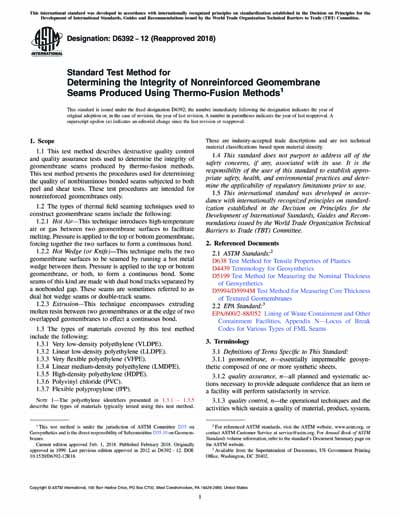Historical
ASTM D6392-12(2018)
Standard Test Method for Determining the Integrity of Nonreinforced Geomembrane Seams Produced Using Thermo-Fusion Methods
1.1 This test method describes destructive quality control and quality assurance tests used to determine the integrity of geomembrane seams produced by thermo-fusion methods. This test method presents the procedures used for determining the quality of nonbituminous bonded seams subjected to both peel and shear tests. These test procedures are intended for nonreinforced geomembranes only.
1.2 The types of thermal field seaming techniques used to construct geomembrane seams include the following:
1.2.1 Hot Air—This technique introduces high-temperature air or gas between two geomembrane surfaces to facilitate melting. Pressure is applied to the top or bottom geomembrane, forcing together the two surfaces to form a continuous bond.
1.2.2 Hot Wedge (or Knife)—This technique melts the two geomembrane surfaces to be seamed by running a hot metal wedge between them. Pressure is applied to the top or bottom geomembrane, or both, to form a continuous bond. Some seams of this kind are made with dual bond tracks separated by a nonbonded gap. These seams are sometimes referred to as dual hot wedge seams or double-track seams.
1.2.3 Extrusion—This technique encompasses extruding molten resin between two geomembranes or at the edge of two overlapped geomembranes to effect a continuous bond.
1.3 The types of materials covered by this test method include the following:
1.3.1 Very low-density polyethylene (VLDPE).
1.3.2 Linear low-density polyethylene (LLDPE).
1.3.3 Very flexible polyethylene (VFPE).
1.3.4 Linear medium-density polyethylene (LMDPE).
1.3.5 High-density polyethylene (HDPE).
1.3.6 Polyvinyl chloride (PVC).
1.3.7 Flexible polypropylene (fPP).
Note 1: The polyethylene identifiers presented in 1.3.1 – 1.3.5 describe the types of materials typically tested using this test method. These are industry-accepted trade descriptions and are not technical material classifications based upon material density.
1.4 This standard does not purport to address all of the safety concerns, if any, associated with its use. It is the responsibility of the user of this standard to establish appropriate safety, health, and environmental practices and determine the applicability of regulatory limitations prior to use.
1.5 This international standard was developed in accordance with internationally recognized principles on standardization established in the Decision on Principles for the Development of International Standards, Guides and Recommendations issued by the World Trade Organization Technical Barriers to Trade (TBT) Committee.
ASTM International [astm]

